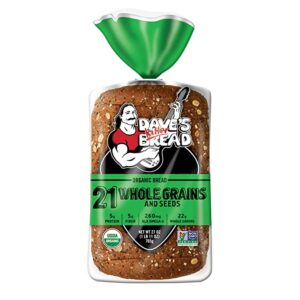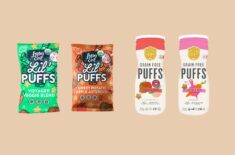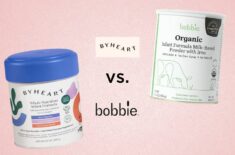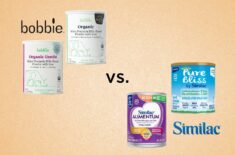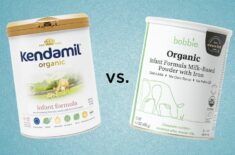When Can Babies Eat Bread In Baby-Led Weaning?
In Baby-led weaning (BLW), you skip the spoon-fed purees, and instead, your baby self-feeds by choosing what and how much they want to eat. You can introduce bread as soon as you have the green light to start on solid foods.
If prepared correctly, bread can be a good finger food option for your little one. Here, we listed the best bread for babies and a few nutritious and easy topping ideas to shake up any slice of bread.
Four Benefits Of Giving Your Little One The Right Kind Of Bread?
It Can Help Develop & Strengthen Their Mouth And Jaw
- Crusty or firm types of bread can help your baby practice chewing and strengthen their mouth and jaw muscles. (1)
- Offer long, thick strips of bagels, frybread, breadsticks, Melba toast, French bread like baguettes, boules, croissants, Italian bread like ciabatta, focaccia, and other similar types of dry bread.
- Toast or roll small pieces of flatbreads like pita, soft tortillas, corn tortillas, and Mexican sopapillas, which have a soft and chewy texture.
It’s A Good Source Of Iron, Protein, Fiber, And Other Nutrients
- Whole wheat bread contains nutrients like protein, iron, carbohydrates, calcium, and more. (2)
- Sprouted grain like amaranth bread is rich in calcium and phosphorus, which aid in the development of bone and teeth. It’s also rich in antioxidants like phenolic acid. (3)(4)
- Buckwheat bread is rich in magnesium and potassium, which help in muscle and nerve control. (5)
- Whole grain bread made from wheat, spelt, rye, quinoa, corn, or millet are rich in fiber and phytochemicals that can help promote healthy cells and good immunity to your baby. (6)(7)
It Can Help Promote A Healthy Gut
- Naturally fermented bread like sourdough, Ethiopian sour flatbread injera, and Portuguese broa contain lactic acid bacteria that promote a healthy gut. (8)(9)
- These “healthy bacteria” or probiotics help your body digest food. They also contain antibacterial properties that fight off “bad bacteria” that can cause illnesses like diarrhea in babies. (10)(11)
Widens Your Baby’s Palate
- Offer a variety of bread that is packed with diverse flavors.
- Challah and brioche have an extra rich flavor because of their high egg content in the dough.
- Bread like rye and wheat offers a different earthy taste.
- Potato bread, cassava bread, or vegetable bread have a mild taste and flaky texture.
- More versatile bread like pita, focaccia, arepa, frybread, Armenian flatbread lavash, and Norwegian potato bread lefse can be paired with sweet or savory dips.
What To Look For When Choosing For Bread For Your Baby
Low Sodium
Check the ingredient list. Too much salt is not recommended for your baby because it might increase their preference for salty foods and their risk for cardiovascular disease (CVD) later in life. (12)
Recommended adequate intake of salt for babies: (13)
0-6 months: Less than 100 milligrams of sodium per serving
7 -12 months: 370 mg per day
1-3 years old: 800 mg per day
Organic Bread
Wherever possible, go for organic and non-GMO types. This is to help ensure that your baby gets optimal nutrition with minimal exposure to possible pesticides and fertilizers. (14)
Look For Bread With Healthy Oils
Olive oil, coconut oil, flaxseed oil, and grapeseed oil contain anti-inflammatory omega-3 fatty acids, antioxidants, and other nutrients good for your baby. It’s best to avoid inflammatory oils like canola oil.
No Added Sugar Or Sweeteners
Too much sugar increases your baby’s risk of developing obesity and diabetes later in life. (15)
No Honey For Babies Under One-Year-Old
It might put your baby at risk for botulism, an illness caused by a bacteria in honey. Its symptoms include muscle weakness, difficulty breathing, and a weak cry. (16)
No Large Seeds
Seeds or nuts in bread are choking hazards. (17)
The Best Bread Choices For Your Baby
Sprouted Grain Bread
- It’s rich in folate, zinc, vitamin C, and iron, promoting healthy brain development and helping strengthen your baby’s immunity. (18)(19)
- It contains compounds that inhibit phytate, a phytic acid that reduces the absorption of nutrients in the body. (18)
- It’s rich in fatty acids and antioxidants that can help boost your baby’s brainpower. (20) (21)
- Top choices of sprouted bread are made of sprouted legumes, sprouted quinoa, and more.
Sourdough
- Because of its natural fermentation process, it produces lactic acid bacteria (LAB). (10)
- While alive, lactic acid bacteria cultivate bacteriocins like lactobacilli and other organic acids that can help keep your baby away from digestive problems like diarrhea, constipation, irritable bowel syndrome, and others. (10)(22)
- Studies also show that a good amount of healthy probiotics can help manage allergies and eczema. (23)
- Grains commonly used in sourdough are rye, spelt, wheat, and einkorn.
Pumpernickel Bread
- Among the types of rye bread, this dark rye bread called pumpernickel is considered the healthiest because it’s made of whole-grain flour. The lighter-colored rye bread already contains refined rye flour. (24)
- It uses a sourdough starter, so it also contains probiotics good for your baby’s gut.
- It’s high in fiber and rich in nutrients like protein, carbohydrates, fat, and iron, which are some of the essentials that promote your baby’s growth and development. (25)
- What sets pumpernickel apart is that it contains lignan, a powerful antioxidant also found in flaxseeds. Lignans also have antibiotic properties, especially for harmful bacteria in the intestines. (26)
100% Whole Wheat Bread
- This type of bread is far more nutritious than commercial white bread in protein and fiber content. (27)
- Whole wheat bread has magnesium and selenium, vital in your baby’s muscle function and energy production. It’s also good for your baby because it’s iron-rich and high in fiber. (28)(29)
- However, it needs to be taken with caution as it contains gluten, a common allergen.
- You can try other whole grains bread made of amaranth, rye, bran, oat, millet, sorghum, and more.
Teff Flour Bread Or Injera
- Teff or injera bread is considered a staple complementary food for some countries like Ethiopia. (30)
- It’s gluten-free and high in calcium, iron, and fatty acids. It also contains strong phytochemicals that strengthen your baby’s immunity. (31)(32)
- If traditional injera is hard to find, you can opt for teff flour bread.
Types Of Bread From Pseudocereals
- Pseudocereals may look like grains, but they’re not. Major pseudocereals are grains like amaranth, quinoa, and buckwheat.
- Types of bread made with amaranth, quinoa, or buckwheat flour are gluten-free and rich in amino acids like lysine essential for your baby’s growth. (33)
- They’re also high in lignans, dietary fiber, and unsaturated fatty acids. (33)
Brands We Recommend:
Dave’s Killer Bread Organic (21 Whole Grains and Seeds)
Essential Baking Company Take & Bake Sourdough



Alvarado Street Sprouted 100% Whole Wheat Bread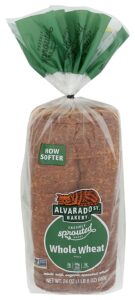


Food for Life Ezekiel 4:9 Flax Sprouted Whole Grain Bread


Udi’s Gluten-Free Frozen Whole Grain Bread



Angelic Bakehouse 7-Grain Sprouted Bread (No Added Sodium)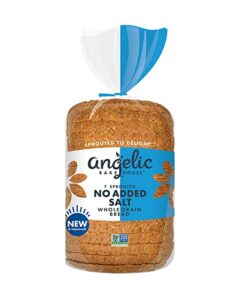

Whole Foods Organic Whole Wheat Sandwich Bread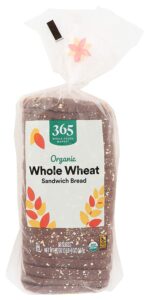

New Grains Gluten-Free Sourdough, (NON-GMO)

How Do You Serve Bread In Blw?
- While bread is rich in nutrients like fiber and carbohydrates, it’s best to offer it only 20% of the time because it is a processed food after all. Instead, offer whole foods in their whole forms like fruits, meats, and veggies 80% of the time for a more balanced diet.
- Pair bread with nutritious food and veggies such as strawberry, sweet potato, or healthy fats like avocado and ghee.
- You can cut it in thick, long strips or offer crusts to help reduce choking risk.
- Our piece on how to safely introduce bread and toast to your little one in BLW has more details.
What Toppings Can I Give My 6 Month Old On Toast?
For nutritious and easy-to-make topping ideas check our list below. It’s a good idea to wait for 1-3 days and watch for allergic reactions when offering new foods to your baby.
5 Easy & Quick Bread & Toast Ideas
1. Banana French Toast
In a bowl, whisk in mashed banana with egg. Add in pieces of bread and a dash of cinnamon. Fry the bread in coconut oil.
2. Thinly Spread Nut Butter Or Peanut Butter
It may be best to consult your baby’s pediatrician before introducing allergenic foods such as nuts or peanuts.
3. Hummus With Sliced Cucumber
Spread hummus thinly on bread and add sliced cucumbers on top for a unique taste.
4. Mashed Beans Or Lentils
Cook beans or lentils as per instructions and mash. Top it on your baby’s toast.
5. Scrambled Egg With A Sprinkle Of Paprika
Place scrambled eggs on toast and sprinkle paprika for some mild seasoning.
Bread Safety Concerns
Is Toast Safer For Your Baby?
Toasting can help prevent the bread from “gumming” or forming a ball in your baby’s mouth, which can cause gagging and can be a choking hazard.
Is Bread A Choking Hazard?
Hard and tough bread or with nuts or seeds can be a choking hazard. (20)
Can Your Baby Eat Bread Every Day?
Experts suggest that your baby be offered a wide variety of baby foods for a more balanced healthy diet. Because bread is a processed food we recommend offering your baby bread 20% of the time and whole foods in their whole form 80% of the time.
Is Bread An Allergen?
Bread may contain common allergens like dairy, eggs, and wheat flour. If your immediate family has a history of food allergies or sensitives, it’s best to discuss your baby’s diet with a pediatrician or dietitian.
Gluten
We have a detailed piece on bread and toast that discusses gluten sensitivity, celiac disease, and more.
REFERENCES
:
- https://www.rch.org.au/uploadedFiles/Main/Content/speech/200101%20FandE%20Chewing%20Practice%20A4%20FSheet_FA_WEB.pdf
- https://fdc.nal.usda.gov/fdc-app.html#/food-details/335240/nutrients
- https://fdc.nal.usda.gov/fdc-app.html#/food-details/170683/nutrients
- https://link.springer.com/article/10.1007/s11130-014-0430-0
- https://fdc.nal.usda.gov/fdc-app.html#/food-details/170687/nutrients
- https://www.hsph.harvard.edu/nutritionsource/what-should-you-eat/whole-grains/
- https://www.gov.nl.ca/healthyeating/baby/offering-healthy-foods/what-foods-should-i-offer-my-baby/whole-grain-foods/
- https://www.researchgate.net/publication/308119354_Microbiological_and_lipid_profiles_of_broa_contributions_for_the_characterization_of_a_traditional_portuguese_bread_httphdlhandlenet1040053876
- https://openaccesspub.org/ijn/article/1088
- https://my.clevelandclinic.org/health/articles/14598-probiotics
- https://pubmed.ncbi.nlm.nih.gov/25930687/
- https://www.malinamalkani.com/blog/the-scoop-on-sodium-and-babies
- https://www.nap.edu/read/25353/chapter/13#230
- https://www.mayoclinic.org/healthy-lifestyle/infant-and-toddler-health/expert-answers/organic-baby-food/faq-20058008
- https://publications.aap.org/aapnews/news/7331
- https://kidshealth.org/en/parents/botulism.html
- https://wicworks.fns.usda.gov/sites/default/files/media/document/English_ReducingRiskofChokinginYoungChildren.pdf
- https://www.health.harvard.edu/blog/sprouted-grains-nutritious-regular-whole-grains-2017110612692
- https://www.cdc.gov/nutrition/micronutrient-malnutrition/micronutrients/index.html
- https://www.ncbi.nlm.nih.gov/pmc/articles/PMC6413227/
- https://www.texaschildrens.org/blog/2012/08/brain-food-toddlers
- https://internationalprobiotics.org/sourdough-part-ii/
- https://www.mcri.edu.au/parents/parent-fact-sheets/fact-sheet-probiotics-infants-and-children
- https://www.glnc.org.au/grains/types-of-grains/rye/
- https://fdc.nal.usda.gov/fdc-app.html#/food-details/174918/nutrients
- https://lpi.oregonstate.edu/mic/dietary-factors/phytochemicals/lignans#food-sources
- https://www.hopkinsallchildrens.org/patients-families/health-library/healthdocnew/why-is-whole-grain-bread-healthier-than-white-brea
- https://fdc.nal.usda.gov/fdc-app.html#/food-details/335240/nutrients
- https://www.gov.nl.ca/healthyeating/baby/offering-healthy-foods/what-foods-should-i-offer-my-baby/whole-grain-foods/
- https://www.omicsonline.org/scientific-reports/2155-9600-SR-621.pdf
- https://www.glnc.org.au/grains/types-of-grains/teff/
- https://www.white-star.de/wse/teff/application.php
- https://www.sciencedirect.com/science/article/pii/S2666154320300338



